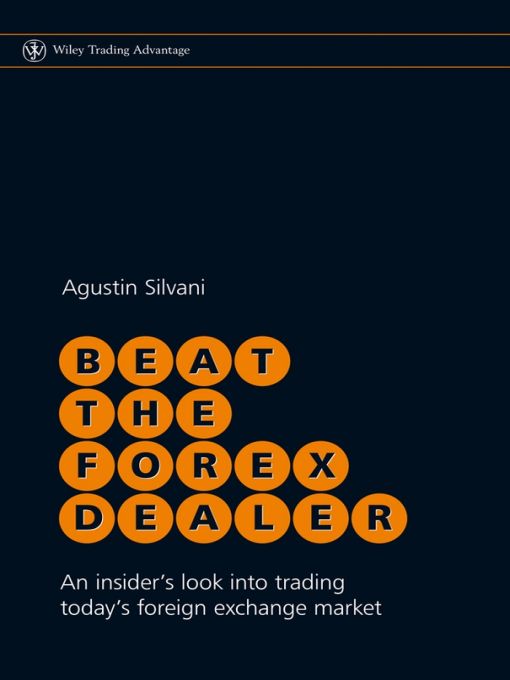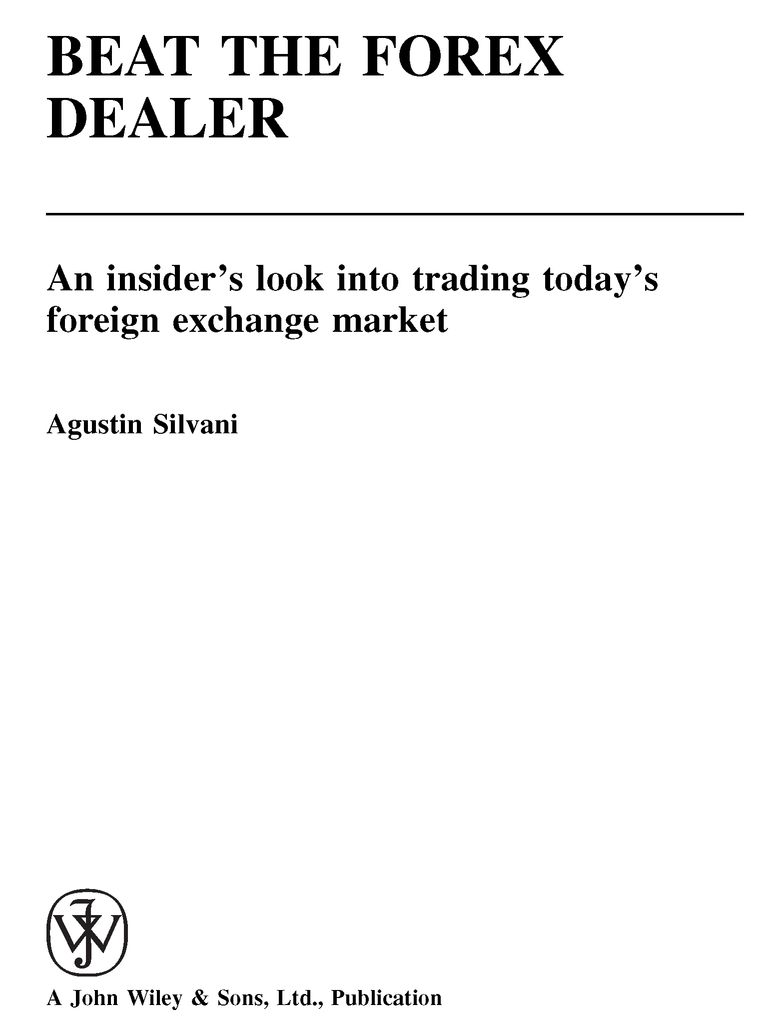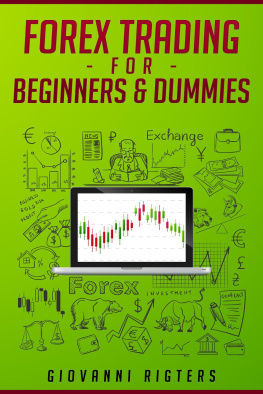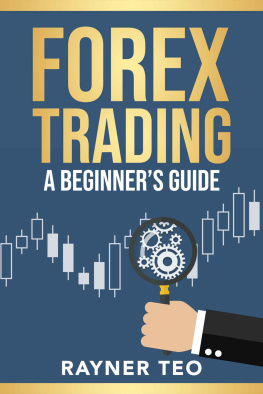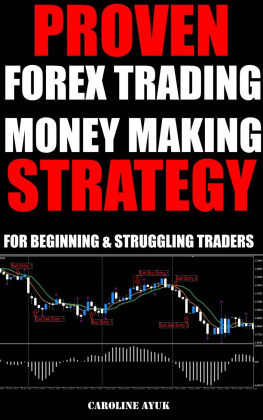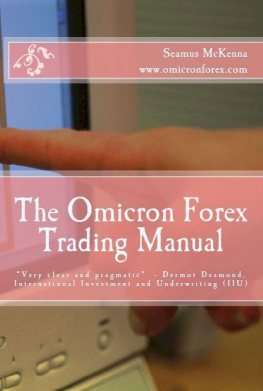Table of Contents
For other titles in the Wiley Trading Series
please see www.wiley.com/finance
Acknowledgements
This book required the expert help and contributions of a wide range of friends and colleagues. Special thanks go out to all of the great people at MIGFX, whose hard work and dedication to trading gave rise to this project. I would also like to give special thanks to Richard Hoffman for his help and dedicated research, and to the many industry contacts whose insights proved invaluable. Without you this book would not have been possible.
I would also like to thank the great people at ProRealTime.com for granting me permission to use their fabulous charts. Every trader should visit their website and check out their charting packages, for they are truly top-notch in the industry.
Introduction
Over the years, I have tried to get my hands on every currency trading book that I could find, but as you may well know the pickings are slim when it comes to FX literature. Apart from a few notable exceptions, most of the available material seems to fall into one of two categories: unabashedly theoretical or completely misguided. The dry, outdated, and sometimes esoteric academic works tend to leave the reader with the perception that currency trading is as gentlemanly and ordered as the world of stamp collecting, when in reality nothing could be further from the truth in a market referred to as a slaughterhouse where traders routinely get chopped up. The FX market I know is one of egos and money, where millions of dollars are won and lost every day, and phones are routinely thrown across hectic trading desks. This palpable excitement has led to the emergence of a second class of literature, often misleading and downright fraudulent, where authors promise the reader riches by offering to make forex trading easy.
Well, Ill let you in on a little secret: there is nothing easy about trading currencies. If you dont believe me, then stop by Warren Buffets office and ask him how he could lose $850 million betting on the dollar or ask King George Soros why his short bets lost him $600 million not once but twice in 1994. Dont these guys read FX trading books? If these investment legends can lose billions in the FX market, what makes anyone think there is anything easy about it?
The average retail trader must feel a terrible disconnect between what is described by famous experts and their actual trading experiences. Theory very rarely translates into fact when it comes to trading, and real-life FX trading is much more complicated and tricky than any guru would have you believe. In this jungle it is a kill-or-be-killed attitude that marks survival, and the minute you step on to the playing field a target has been placed next to your account number.
Realizing that most FX books in print are either written by scam artists or academics with little real-world trading experience, I decided to put my own thoughts to paper. While I certainly do not proclaim to be any sort of market wizard, the market insights I have gained while managing a successful currency fund should prove valuable to readers, even if they are just starting their trading careers. Being a firm believer in the small is beautiful mantra, I have therefore tried to keep this book short, and to the point.
The purpose of this book is two-fold. First, by explaining the day-to-day mechanics of the FX market and pointing out some of the more unsavory dealings going on in the retail side, I hope to make evident for the reader the risks and rewards involved in currency trading. The second objective of the book is to help turn average traders into winning traders. Average traders are losing traders; winning traders are in fact quite rare. However, by highlighting some market-proven trading tricks and techniques, I hope to give traders an initial leg-up.
As you may have guessed, this book takes its name from Edward O. Thorps landmark work on blackjack, Beat the Dealer. In 1962, the MIT mathematics professor revealed to the public the gambling industrys tricks and traps, while at the same time managing to teach a successful method for playing the game of twenty-one. Likewise, you will find this book roughly split into two parts: the first half is dedicated to revealing the foreign exchange markets unfair practices and the second half is designed to help the retail FX trader implement an effective and winning game plan by providing trading tips and detailed examples.
FROM VEGAS TO WALL STREET
The past five years has seen the FX market open its arms to nontraditional participants, and now everyone from dotcom investors to cash-strapped grandmas are jumping in hoping to strike it rich.
What most of these new participants fail to realize is that they are stepping on to a battlefield littered with the remains of day traders and genius systems. It is frequently noted that over 90 % of FX traders do not survive in the long run, yet you wont find that statistic in any of the publicity dished out by the FX brokers. To be profitable, retail traders must realize that the foreign exchange market was fundamentally developed as a professionals market, and its outdated conventions and procedures mean that it still is very much geared toward the professional. In a market where the retail trader exerts little (though growing) influence, most can have little hope of success.
The retail brokers who have sprung up recently would like you to believe that currency trading is a high form of financial speculation. In reality, the average clients trading approach combined with the unscrupulous practices of some brokers make spot FX trading more akin to the games found on the Vegas strip than to anything seen on Wall Street. The new breed of on-line FX brokers simply share too many of the traits employed by casinos to stack the odds in their favor, including these:
The house always has the advantage (the spread).
The house feeds off the players greed and actively promotes it (by offering trading signals, excessive leverage, and fancy platforms resembling slot machines!).
The house adopts various dubious risk-management controls, which include cheating and cutting off winning players.
All of these benefits ensure that, in the long run, the house (broker) will end up with virtually all of the players (traders) money. The odds are simply stacked in their favor.
Thorps original Beat the Dealer was brilliant in that he focused his energy on a niche game (blackjack) which featured changing odds. In a game with fixed odds (such as the lottery) a player is virtually assured ruin, while a game with shifting odds allows the smart player to effectively control his risk while maximizing his gains. Although the long-run odds may not favor the player, a set of rules can be adopted that allow the gambler to play only when the odds are in his favor, thus greatly improving his chance for success. Playing in this way enables you to refrain from gambling (betting on luck) and concentrate on playing the probabilities. FX traders need to take a cue from their card-playing counterparts and learn to trade only when the odds are shifted in their favor. In this spirit, the last part of this book is dedicated to exposing high-probability trades commonly seen in the intra-day FX market, which can effectively be used to double up when they are seen.

